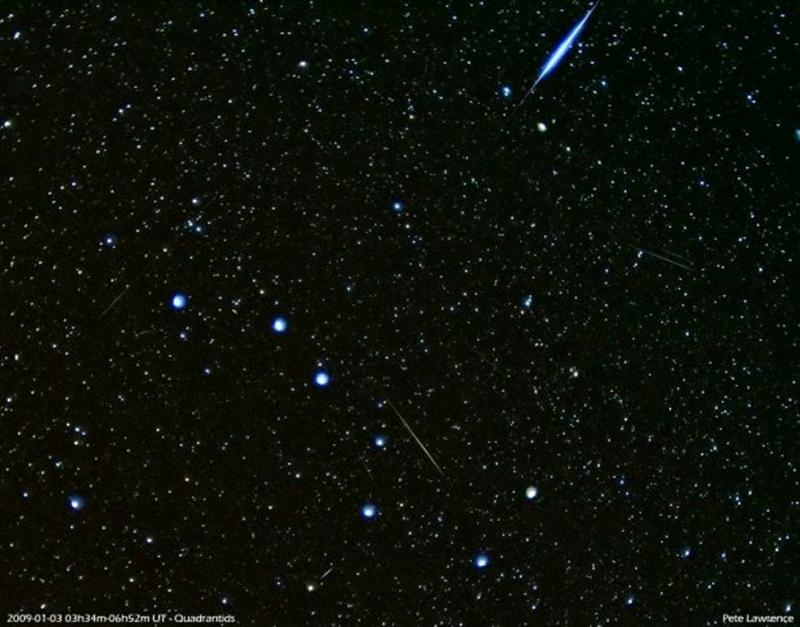2022 January 1
The First Meteor Shower of the Year
Much has been made in the popular astronomical press of the fact that many of the most important annual meteor showers in 2022 suffer some interference by moonlight. This is certainly not the case for the first major shower of the year, the Quadrantids, which peak in early January every year, but this year coincide with a virtually New Moon – good news indeed!
When and How to Observe
Active from January 1-6, the Quadrantids are only poorly observed in most years thanks to a combination of factors: a very narrow period of high activity, generally poor weather in early January and interference by moonlight in at least one year out of three! Meteors from the shower radiate from the northern edge of the constellation Boötes, the Herdsman (RA 15h 18m, Dec +50o), not far from the tip of the tail of the Great Bear, Ursa Major. Unfortunately, activity is close to peak levels for only about six hours and there is a notable variation in peak rates from year to year. The best reported observed rates for a single visual observer under ideal conditions are typically 50-70 m/h. The brighter Quadrantids may leave persistent trains.
From the latitudes of Britain and Ireland the Quadrantid radiant is circumpolar, but peak activity this year is predicted for the early evening of Monday, January 3rd when the radiant is unfortunately rather low in the northern sky. However, it is rising higher by midnight and climbs to a very favourable elevation as dawn approaches. Although observations should certainly be carried out in the early evening of January 3rd at the time of the peak, watches during the early morning hours of January 3rd (before the peak) and January 4th (after the peak) may be the most productive. The radiant reaches an elevation of around 70 degrees as dawn twilight begins. The long hours of darkness mean that visual observers may carry out several watches of an hour’s duration with rest breaks in between during the course of the night.

A ‘Lost’ Constellation
The Quadrantid shower takes its name from the now obsolete constellation of Quadrans Muralis ((Latin for ’mural quadrant’). This region was once occupied by the constellation Le Mural, created in 1795 by the French astronomer, Joseph Jérôme de Lalande (1732–1807), Director of the Observatory of l’Ecole Militaire in Paris, to commemorate the observatory’s wall-mounted quadrant used for measuring star positions. Johann Elert Bode Latinized its name from Le Mural to Quadrans Muralis in 1801 in his Uranographia star atlas. The pattern was sufficiently well known by the 1830s when the meteor shower was first recognised and named by Adolphe Quetelet of Brussels Observatory. However, in 1922 the International Astronomical Union (IAU) formalised its list of 88 officially recognised constellations, and Quadrans Muralis was removed; it is now part of the constellation of Boötes.
An Interesting Origin
Unlike most meteor showers which originate from periodic comets, the Quadrantids most probably originate from an asteroid-like body 2003 EH1. It has an odd, high-inclination orbit that matches the orbit of the Quadrantids when both are tracked back through several centuries of planetary perturbations. It is thought that the Quadrantid meteoroids we encounter today left 2003 EH1 only about 500 years ago and there is some evidence that 2003 EH1 may be connected with the bright comet C/1490 Y1 seen by Chinese, Japanese and Korean observers between December 1490 and February 1491. The association of 2003 EH1 with the Quadrantid stream identifies it as a ‘dead’ short-period comet, which has lost all of its volatile ices and gases, somewhat like the “rock comet” 3200 Phaethon, parent of the annual Geminid shower in December.
Get Involved
The BAA’s visual meteor report forms, available as downloads in both pdf and Excel formats, enable observers to record the details of each meteor seen. These include: time of appearance (UT); apparent magnitude (brightness); type (shower member, or random, ‘background’ sporadic); constellation in which seen; presence and duration of any persistent train. Other notes may mention flaring or fragmentation in flight, or marked colour. Watches should ideally be of an hour’s duration or longer (in multiples of 30 minutes), but do take breaks as required to keep alert and focussed. Observers are reminded to carefully record the observing conditions and the stellar limiting magnitude. Wrap up warmly and enjoy what should be a very interesting display.
By whatever means you observe the Quadrantids this year, please submit your results to the BAA Meteor Section via meteor@britastro.org.
Dr John Mason
Director, BAA Meteor Section
| The British Astronomical Association supports amateur astronomers around the UK and the rest of the world. Find out more about the BAA or join us. |
